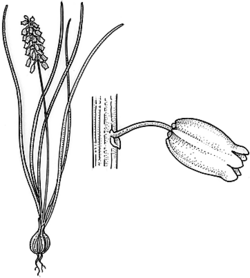Common name: Grape Hyacinth, Armenian Grape Hyacinth
Muscari armeniacum Leichtlin ex Baker APNI* 
Description: Erect herb to 45 cm high; bulb 15–30 mm diam.
Leaves 3–8, to 40 cm long, 2–10 mm wide, narrowly channelled.
Scape to 40 cm long; flowers crowded, scented. Fertile flowers with pedicels 2–5 mm long; perianth broad-urceolate, dark blue with paler or white lobes, 4–6 mm long. Sterile flowers with pedicels 1–2 mm long; perianth obovoid, deep blue, 2–4 mm long. Staminal filaments 0.75–1 mm long
Capsule 7–9 mm long, broad-obovoid.
Flowering: Flowers early spring.
Distribution and occurrence: Native to Asia Minor and the Balkan Peninsula. Cultivated in Australia and naturalised in southeastern South Australia, New South Wales, Australian Capital Territory, Victoria and Tasmania. Commonly cultivated as ornamentals in cooler regions, recorded as naturalized in A.C.T., Cooma and Lidsdale districts and Blayney in NSW.
NSW subdivisions: *CT, *ST
Other Australian states: *Vic. *Tas. *S.A.
Text by D. C. Godden; L. Murray (Sep 2018)
Taxon concept: Flora of NSW 4 (1993); https://profiles.ala.org.au/opus/foa/profile/Muscari%20armeniacum
APNI* Provides a link to the Australian Plant Name Index (hosted by the Australian National Botanic Gardens) for comprehensive bibliographic data
***The AVH map option provides a detailed interactive Australia wide distribution map drawn from collections held by all major Australian herbaria participating in the Australian Virtual Herbarium project.
|


